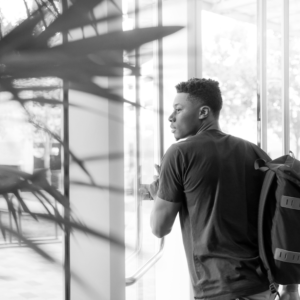Simplifying Applications and Matriculation at Community Colleges
HIGHLIGHTS
• Seemingly minor hassles on the path to college may knock students off track
• Nationally, between 10-40% of students accepted to college don’t matriculate
• We generated insights and a toolkit for supporting prospective students through applying and enrolling
The Challenge
Community colleges offer economic opportunity to millions of Americans. While community colleges are more affordable than public and private four-year institutions of higher education and generally open their doors to all students interested in attending, complexities in the application and matriculation process (common among all colleges and universities) can still prohibit many prospective students from getting to day one. In fact, between 10 and 40 percent of students who are accepted to college don’t matriculate, a phenomenon known as melt.
With 115 colleges, the California Community Colleges (CCC) represent the largest system of higher education in the United States. Almost all CCC applications are managed through a central portal called CCCApply, and internal data from the CCC system also showed a high degree of attrition between application and matriculation. With a desire to innovate and offer even more support for potential students, the California Community Colleges Chancellor’s Office and the Foundation for California Community Colleges partnered with us to apply behavioral science to the overall student journey, aiming to help prospective students successfully apply and matriculate. Generously supported by College Futures Foundation and the Stupski Foundation, we focused our efforts on two goals to increase access to the economic opportunities that CCC offers:
- Help more prospective students successfully complete applications, and help them do so faster, with fewer hassles and more confidence.
- Reduce melt to help more prospective students get to the first day of classes once they’ve applied.
Our Approach
We diagnosed several behavioral barriers that students face in successfully applying to college and worked with individuals across the CCC system to design solutions to address these behavioral barriers. Insights from this project are currently being applied throughout the CCC system. A few examples of the suggested changes to CCCApply include:
- Improved skip logic so that prospective students see only the questions that are relevant to their particular circumstances, removing the hassle of having to skip irrelevant questions.
- New language surrounding legally-mandated questions about student identity—particularly those about gender and sexual orientation—which felt evaluative to some students. The new language will help affirm students of all identities and clarify that answers to these questions will be used only for aggregate data collection.
- An interactive questionnaire that walks prospective students through the process of choosing a major and refers them to in-person help as needed.
Finally, we focused on the steps that come after the application and admission to help more students make it to day one. We found that deadlines within the matriculation process can often be hard to pinpoint, and that balancing a welcoming tone with urgent reminders can be challenging. From these insights, we produced a toolkit that individual colleges can use to incorporate behavioral best practices into their existing communications with students, like emphasizing deadlines and using checklists that can be applied at colleges across the state.
Takeaway
For many students, enrolling at a community college is a crucial step toward earning a certificate or degree and launching a new phase of their career. Behavioral science can help us understand more clearly why some prospective students who want to apply and enroll don’t always make it through the process. The behavioral design principles that we defined through this project will be used by the CCC system in the years to come. With over one million applications being submitted though CCCApply each year, this project has the potential to help millions of prospective students make it through the college application process and into classes that will help them build a better future.
To learn more, read the toolkit of behavioral best practices for post-application steps, a full report by the Foundation for California Community Colleges on this work, and our project brief for more detail.
Interested in learning more about our work applying behavioral science to the postsecondary education space? Reach out to us at education@ideas42.org or tweet at @ideas42 to join the conversation.
Partners










